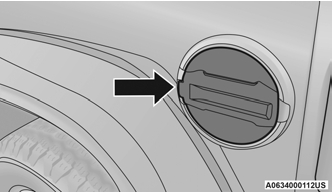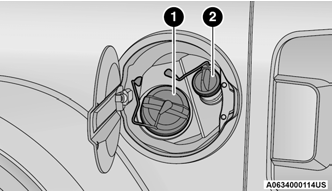Jeep Wrangler: STARTING AND OPERATING / REFUELING THE VEHICLE — DIESEL ENGINE (IF EQUIPPED)
The fuel filler cap is located on the driver's side of the vehicle. If the fuel filler cap is lost or damaged, be sure the replacement cap is the correct one for this vehicle.

Fuel Filler Door

Fuel and Diesel Exhaust Fluid (DEF) Fill Location
- Diesel Fuel Filler
- DEF Filler
NOTE:
- When the fuel nozzle “clicks” or shuts off, the fuel tank is full.
- Tighten the fuel filler cap about a quarter turn until you hear one click. This is an indication that the cap is properly tightened.
CAUTION!
For diesel engines, only use diesel fuel for motor vehicles in accordance with EN 590 European specifications. The use of other products or mixtures may damage the engine beyond repair and consequently void the warranty, due to the damage caused. If you accidentally introduce other types of fuel into the tank, do not start the engine. Empty the tank. If the engine has been run for even an extremely limited amount of time, you must not only drain the fuel tank, but the rest of the supply circuit as well.
 Loose Fuel Filler Cap Message
Loose Fuel Filler Cap Message
After fuel has been added, the vehicle
diagnostic system can determine if the fuel filler
cap is possibly loose, improperly installed, or
damaged. If the system detects a malfunction,
the “gASCAP” message will display in the
odometer display...
 Avoid Using Contaminated Fuel
Avoid Using Contaminated Fuel
Fuel that is contaminated by water or dirt can
cause severe damage to the engine fuel
system. Proper maintenance of the engine fuel
filter and fuel tank is essential...
Other information:
Jeep Wrangler 2018-2025 Owners Manual: Maintenance-Free Battery
Your vehicle is equipped with a maintenance-free battery. You will never have to add water, and periodic maintenance is not required. WARNING! Battery fluid is a corrosive acid solution and can burn or even blind you. Do not allow battery fluid to contact your eyes, skin, or clothing...
Jeep Wrangler 2018-2025 Owners Manual: CRUISE CONTROL SYSTEMS — IF EQUIPPED
Your vehicle may be equipped with the Cruise Control system, or the Adaptive Cruise Control (ACC) system: Cruise Control for cruising at a constant preset speed. Adaptive Cruise Control (ACC) for maintaining a set distance between you and the vehicle ahead using Fixed Speed Cruise Control to automatically adjust the preset speed...
